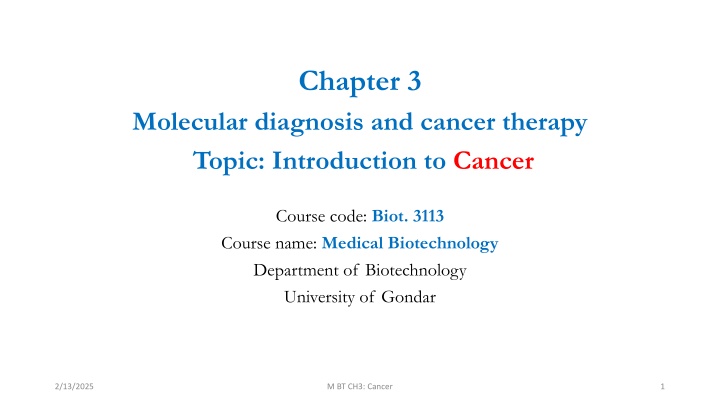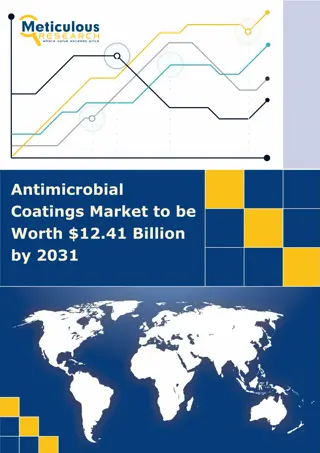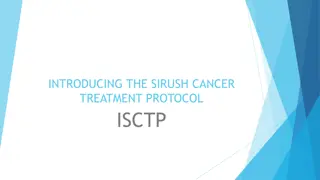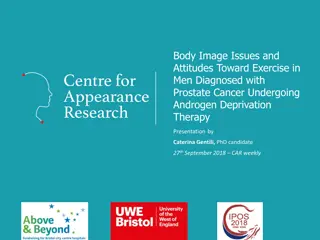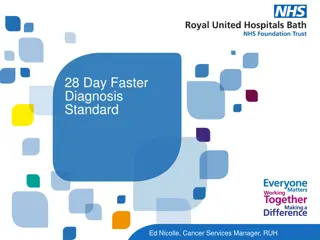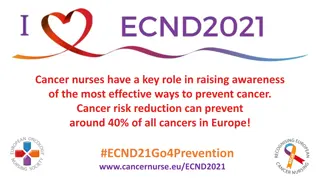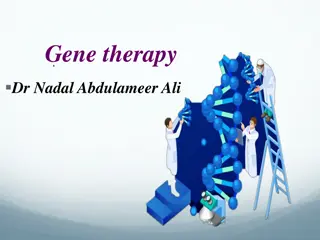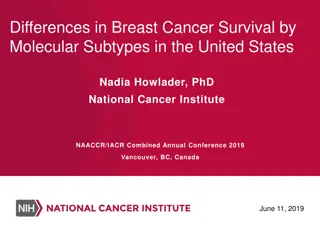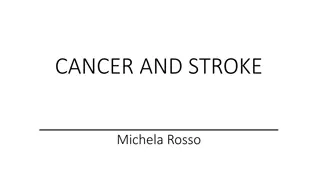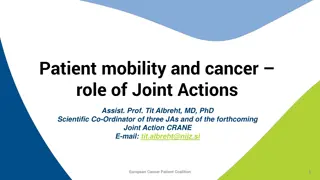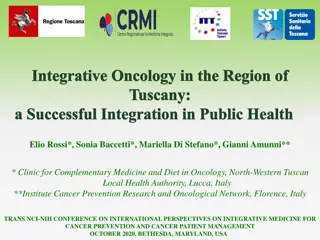Molecular Diagnosis and Cancer Therapy Overview
This content delves into the molecular aspects of cancer diagnosis and therapy, discussing markers, DNA synthesis and repair, anti-gene therapy, immunology, cell cycle control, traits of cancer cells, and the transition of normal cells to cancer cells through oncogenes and chromosomal changes.
Download Presentation

Please find below an Image/Link to download the presentation.
The content on the website is provided AS IS for your information and personal use only. It may not be sold, licensed, or shared on other websites without obtaining consent from the author.If you encounter any issues during the download, it is possible that the publisher has removed the file from their server.
You are allowed to download the files provided on this website for personal or commercial use, subject to the condition that they are used lawfully. All files are the property of their respective owners.
The content on the website is provided AS IS for your information and personal use only. It may not be sold, licensed, or shared on other websites without obtaining consent from the author.
E N D
Presentation Transcript
Chapter 3 Molecular diagnosis and cancer therapy Topic: Introduction to Cancer Course code: Biot. 3113 Course name: Medical Biotechnology Department of Biotechnology University of Gondar 2/13/2025 M BT CH3: Cancer 1
Molecular diagnosis and cancer therapy Markers for cancers Cancer therapy: DNA synthesis and repair Anti-gene therapy: RNAi approaches: ribozyme technology, antisense techn. Immunology and immunotherapy for cancer: Tumor immunotherapy and tumor suppressors, Drug resistance, Hematopoietic gene transfer, Translational research, Gene delivery systems (viral and non-viral), Apoptosis: mechanisms and therapies, Vaccine development for cancer. 2/13/2025 M BT CH3: Cancer 2
DNA Mitotic Phase (M) DNA DNA DNA Interphase DNA DNA G1 Cell growth G2 Cell growth preparation for division Interphase S DNA replication DNA DNA DNA Interphase M BT CH3: Cancer 2/13/2025 3
Proteins within the cell control the cell cycle Signals affecting critical checkpoints determine whether the cell will divide (cyclins, kinases) Anchorage, cell density, and chemical growth factors affect cell division Growth factors bind to specific receptors on the plasma membrane to trigger cell G1 checkpoint division Cancer cells have abnormal cell cycles Control system divide excessively and form tumors M checkpoint G2 checkpoint 2/13/2025 M BT CH3: Cancer 4
Traits of cancer cells 1. Independent of GROW signal from other cells. often, oncogenes. Ex. ras 2. Ignores STOP signal defective damage control, so problems not corrected. Often, tumor suppressor genes. Ex. P53 3. No cell suicide (apoptosis) 4. No limit to cell divisions telomeres rebuilt on ends of the chromosomes new treatment target: telomerase 5. Angiogenesis - formation of blood vessels 6. Metastasis - ability to move to other tissues benign: do not move from tumor site malignant: invasive cells, can travel in blood and lymph system Malignant tumors can invade other tissues and may kill the organism 2/13/2025 M BT CH3: Cancer 5
How do normal cells become cancerous? Source of oncogenes? Mutation of a normal gene = change in DNA sequence UV light, X rays, natural or synthetic chemicals Virus (ex. HPV and cervical cancer) Chromosomal changes can be large or small Deletion chronic myelogenous leukemia Homologous chromosomes Duplication Inversion Reciprocal translocation Nonhomologous chromosomes Chromosomal translocation can activate an oncogene 2/13/2025 M BT CH3: Cancer 6
Cancer Cancer is one of the most common diseases in the developed world: 1 in 4 deaths are due to cancer 1 in 17 deaths are due to lung cancer Lung cancer is the most common cancer in men Breast cancer is the most common cancer in women There are over 100 different forms of cancer 2/13/2025 M BT CH3: Cancer 7
Cancer The division of normal cells is precisely controlled. New cells are only formed for growth or to replace dead ones. Cancerous cells divide repeatedly out of control even though they are not needed, they crowd out other normal cells and function abnormally. They can also destroy the correct functioning of major organs. What causes cancer? Mutations: Cancer arises from the mutation of a normal gene. Mutated genes that cause cancer are called oncogenes. It is thought that several mutations need to occur to give rise to cancer Apoptosis: Cells that are old or not functioning properly normally self destruct and are replaced by new cells. However, cancerous cells do not self destruct and continue to divide rapidly producing millions of new cancerous cells. 2/13/2025 M BT CH3: Cancer 8
Carcinogens Ionising radiation X Rays, UV light Chemicals tar from cigarettes Virus infection papilloma virus can be responsible for cervical cancer. Hereditary predisposition Some families are more susceptible to getting certain cancers. Benign or malignant? Benign tumours do not spread from their site of origin, but can crowd out (squash) surrounding cells e.g. brain tumour, warts. Malignant tumours can spread from the original site and cause secondary tumours. This is called metastasis. They interfere with neighbouring cells and can block blood vessels, the gut, glands, lungs etc. 2/13/2025 M BT CH3: Cancer 9
The Development of Cancer 2/13/2025 M BT CH3: Cancer 10
Factors Believed to Contribute to Global Causes of Cancer 2/13/2025 M BT CH3: Cancer 11
Risks For Cancer Lifetime risk the probability that an individual, over the course of a lifetime, will develop cancer or die from it Relative risk measure of the strength of the relationship between risk factors and a particular cancer Smoking 30% of all cancer deaths, 87% of lung cancer deaths Obesity 50% higher risk for breast cancer in postmenopausal women, 40% higher risk in colon cancer for men 2/13/2025 M BT CH3: Cancer 12
Biological Factors Some cancers such as breast, stomach, colon, prostate, uterus, ovaries and lung appear to run in families Hodgkin s disease and certain leukemia's show similar patterns University of Utah research suggests that a gene for breast cancer exists A rare form of eye cancer appears to be transmitted genetically from mother to child Reproductive And Hormonal Risks For Cancer Pregnancy and oral contraceptives increase a woman s chances of breast cancer Late menarche, early menopause, early first childbirth, having many children have been shown to reduce risk of breast cancer 2/13/2025 M BT CH3: Cancer 13
Occupational And Environmental Factors Ethiopia Asbestos Nickel Chromate Benzene Arsenic Cool tars Radioactive substances Herbicides/pesticides 2/13/2025 M BT CH3: Cancer 14
Social And Psychological Factors Stress has been implicated in increased susceptibility to several types of cancers Sleep disturbances, diet, or a combination of factors may weaken the body s immune system Chemicals In Foods Sodium nitrate when ingested forms a potential carcinogen, nitrosamine Sodium nitrate is still used because it is effective in preventing botulism Pesticide and herbicide residues 2/13/2025 M BT CH3: Cancer 15
Viral Factors Herpes related viruses may be involved in the development of leukemia, Hodgkin s disease, cervical cancer, and Burkitt s lymphoma Epstein-Barr virus associated with mononucleosis (an abnormally high proportion of monocytes in the blood), may contribute to cancer Human papillomavirus (HPV) virus that causes genital warts, has been linked to cervical cancer Helicobacter pylori causes ulcers which are a major factor in the development of stomach cancer 2/13/2025 M BT CH3: Cancer 16
Medical Factors Some medical treatments actually increase a person s risk for cancer Diethylstilbestrol (DES) used 1940 to 1960 to control bleeding during pregnancy, the daughters of mothers that used DES were found to have an increased risk for cancers of the reproductive organs Estrogen supplementation Chemotherapy used to treat one form of cancer may increase risk for another type of cancer Types of Cancers Classification of cancers Carcinomas: a cancer arising in the epithelial tissue of the skin or of the lining of the internal organs. Sarcomas a malignant tumour of connective or other non-epithelial tissue. Lymphomas cancer of the lymph nodes Leukemias bone marrow and other blood-forming organs 2/13/2025 M BT CH3: Cancer 17
Colon And Rectal Cancers Third most common cancer in men and women Risk factors: over 50 years old, obese, family history of colon or rectum cancer or polyps, diets high in fats, low in fiber, smoking, high alcohol consumption, lack of exercise 90% of colorectal cancers are preventable Treatment: radiation, surgery, and possible chemotherapy Prevention: regular exercise, a diet heavy in fruits and plant-origin foods, a health weight, and moderation in alcohol consumption 2/13/2025 M BT CH3: Cancer 18
Prostate Cancer 1 in 3 men will be diagnosed in their lifetime Prostate is a muscular, walnut-sized gland the surrounds part of the urethra. Its primary function is to produce seminal fluid. Symptoms: nonspecific, weak or interrupted urine flow, difficulty starting or stopping urination Risk factors: age, race, nationality, family history, diet, lifestyle, and vasectomy Prevention: diet high in lycopenes, vitamin E 2/13/2025 M BT CH3: Cancer 19
Skin Cancer Long term effects of sun exposure can result in skin cancer Malignant melanoma, deadliest form of skin cancer Sun give off 3 types of harmful rays: UVA UVB UVC Prevention: limit exposure to harmful UV rays, drink more fluids than usual, apply cool compresses to skin, moisturize skin The ABCD rule Asymmetry half of mole does not look like the other half Border irregularity the edges are uneven Color pigmentation is not uniform 2/13/2025 M BT CH3: Cancer 20 Diameter greater than 6 mm
Testicular Cancer Men between the ages 15-35 are at the greatest risk Important to practice regular testicular self exams Ovarian Cancer Fifth leading cause of cancer death for women Most common symptom is enlargement of the abdomen Risk factors include: family history, age, childbearing, cancer history, fertility drugs, talc use in genital area, genetic predisposition Prevention: diet high in vegetables and low in fat, exercise, sleep, stress management, and weight control 2/13/2025 M BT CH3: Cancer 21
Cervical and Endometrial (Uterine) Cancer 2nd leading cancer in Ethiopia Pap test cells are taken from the cervical region Risk factors: Cervical cancer: early age at first intercourse, multiple sex partners, cigarette smoking, and certain STIs Endometrial cancer: age, endometrial hyperplasia, overweight, diabetes, and high blood pressure Other Cancers Pancreatic cancer silent 4% 5-year survival rate Leukemia cancer of blood forming tissues 2/13/2025 M BT CH3: Cancer 22
Detecting Cancer The earlier the diagnosis the better the prospect for survival Magnetic resonance imaging (MRI) Computerized axial tomography scan (CAT scan) Prostatic ultrasound Regular self-exams, and check ups New Hope In Cancer Treatments Remove less surrounding tissue during surgery Combine surgery with radiation or chemotherapy Immunotherapy Cancer-fighting vaccines Gene therapy Stem cell research 2/13/2025 M BT CH3: Cancer 23
2/13/2025 M BT CH3: Cancer 24
